When Nvidia launched the original GeForce RTX 4080 it had a mixed reception, while some liked it. Many were disappointed with its price. It launched at $1200 which was $400 less than the top-of-the-line class card the GeForce RTX 4090. But the main problem that many had with it was the cost per frame value it provided and at that point saving up for the better card became a thing to consider.
Well, things have changed now, and since Nvidia is quite famous for correcting their wrongs when launching the Super series cards. The good news is they have done that, the new card costs less while improving on its performance. But just how much better is it? The short answer is, that it is good for the price, but if you are wondering what exactly has changed, then below is the answer you are looking for.
RTX 4080 Super Specs and Upgrades
Here is a quick overview of what all has been improved from the original RTX 4080:
- Nvidia CUDA Cores: Increased to 10240 from 9728.
- Boost Clock Speed: Increased to 2.55 GHz from 2.51 GHz.
- Base Clock Speed: Increased to 2.29 GHz from 2.21 GHz.
- Tensor Cores: Increased to 320 from 304.
- Ray Tracing Cores: Increased to 121 TFLOPS from 113 TFLOPS.
- Price: Dropped to $999 from $1199.
Aside from the above changes you will find that both 4080 Super and 4080 have pretty much the same specs. We will check a list of all its specs along with the specs of other cards by Nvidia that can be considered its competition in a bit, but for now, here is how the new design looks like.
Design and Looks
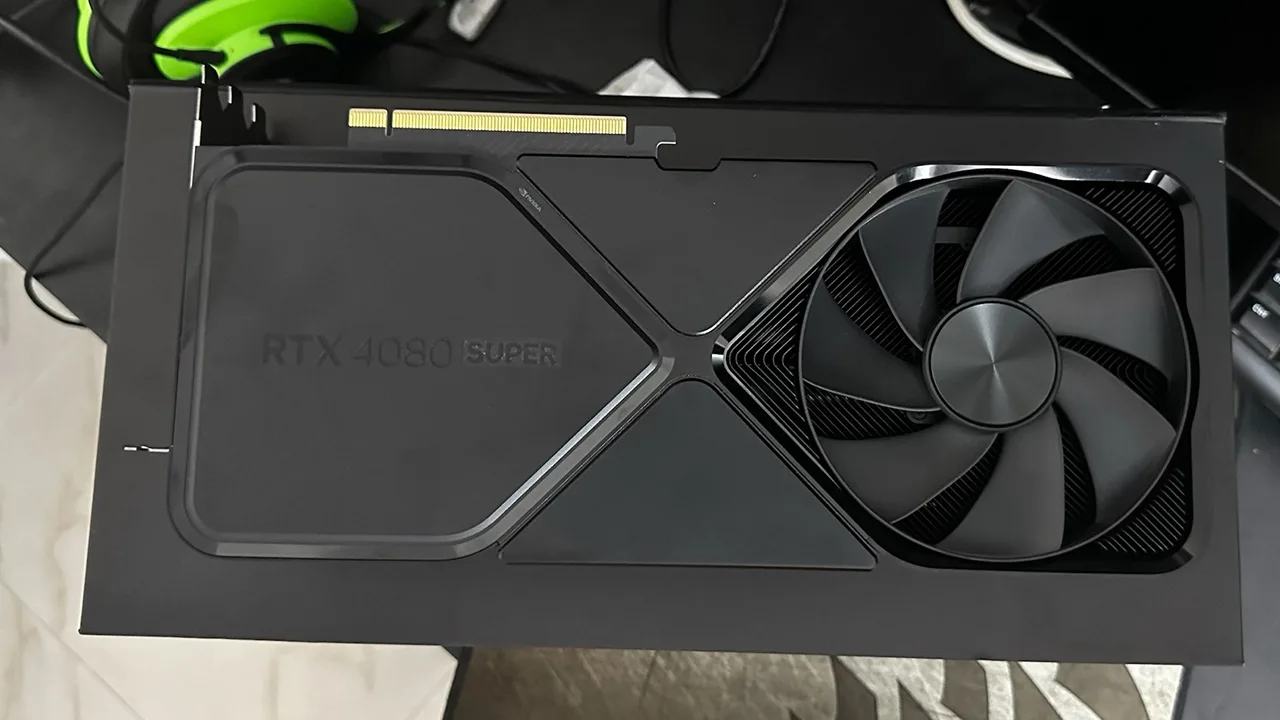
Speaking of the card’s design and looks Nvidia has decided to spice things up this time around. They went ahead with a pure Black matte design which can be annoyingly a finger-print magnet. Luckily, you won’t have to bother about it much as it can be cleaned quite easily. You can see a minimal GeForce RTX on its side.
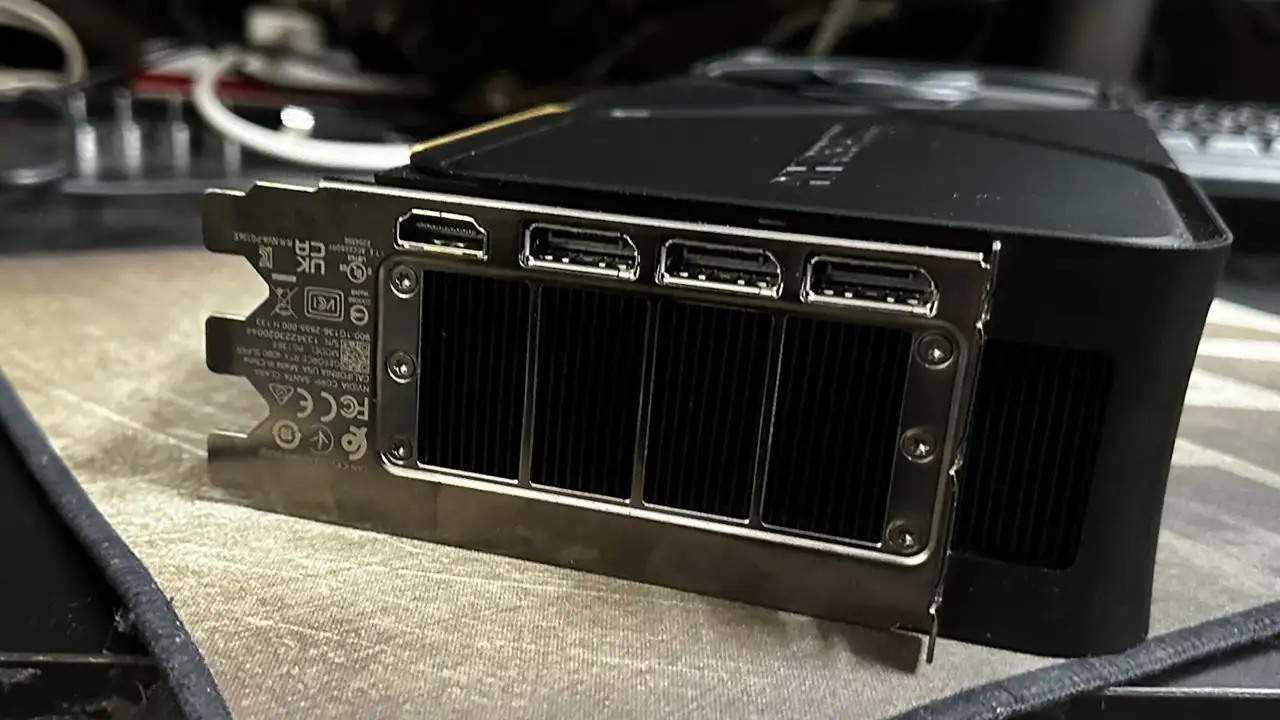
Its dimensions are as follows:
- Length: 304 mm
- Width: 137 mm
- Height: 61 mm
- Slots: 3-Slot
Now, this card might feel quite large, which in many ways it is. But it is there up in the leagues with the RTX 4090 and RTX 4080. Also keep in mind its TGP is 320 W, so it is reasonable to expect the card to heat up easily. However, the card’s big design works in its favor and it stays quite cool while also being quiet.
On its back you can find the following Display Output Slots:
- HDMI 2.1: x1
- DisplayPort 1.4a: x3
As for its power connector requirements, you have the options of 3x PCIe 8-pin cables (adapter is included in the box) or 1x 450 W or greater PCIe Gen 5 cable.
How DLSS 3 and Ray Tracing Change the Game
Nvidia graphic cards and their upgrades for DLSS and Ray Tracing technologies always go hand in hand. However, since this isn’t exactly a generational upgrade but rather the Super version of the 4080, you will find there is only a slight improvement in this field. When you compare games on the two cards side by side you can notice a boost anywhere between 2-5% depending on the title.
For beginners who are new to these things, DLSS 3 offers AI Super Resolution and AI Frame Generation. What Frame Generation does is it takes two frames and adds a frame in between. Depending on the game you are playing it can essentially double your frame rate, if not improve it by a bit. The games that support this feature give you an even better and smoother experience.
However, since these are artificial frames you shouldn’t use them in games that require low latency and less input lag. So you should avoid using them in FPS titles.
As for Ray Tracing, it is a rendering method that simulates the lighting of different objects in a scene. It does that by first rendering physically accurate reflections, refractions, shadows, and indirect lighting. Here is another simpler explanation of it by Nvidia:
Another way to think of ray tracing is to look around you, right now. The objects you’re seeing are illuminated by beams of light. Now turn that around and follow the path of those beams backwards from your eye to the objects that light interacts with. That’s ray tracing.
To give you a better and visual example of how Ray Tracing affects in making the game look better here are a few examples of how the game looks when left disabled and after you enable it:
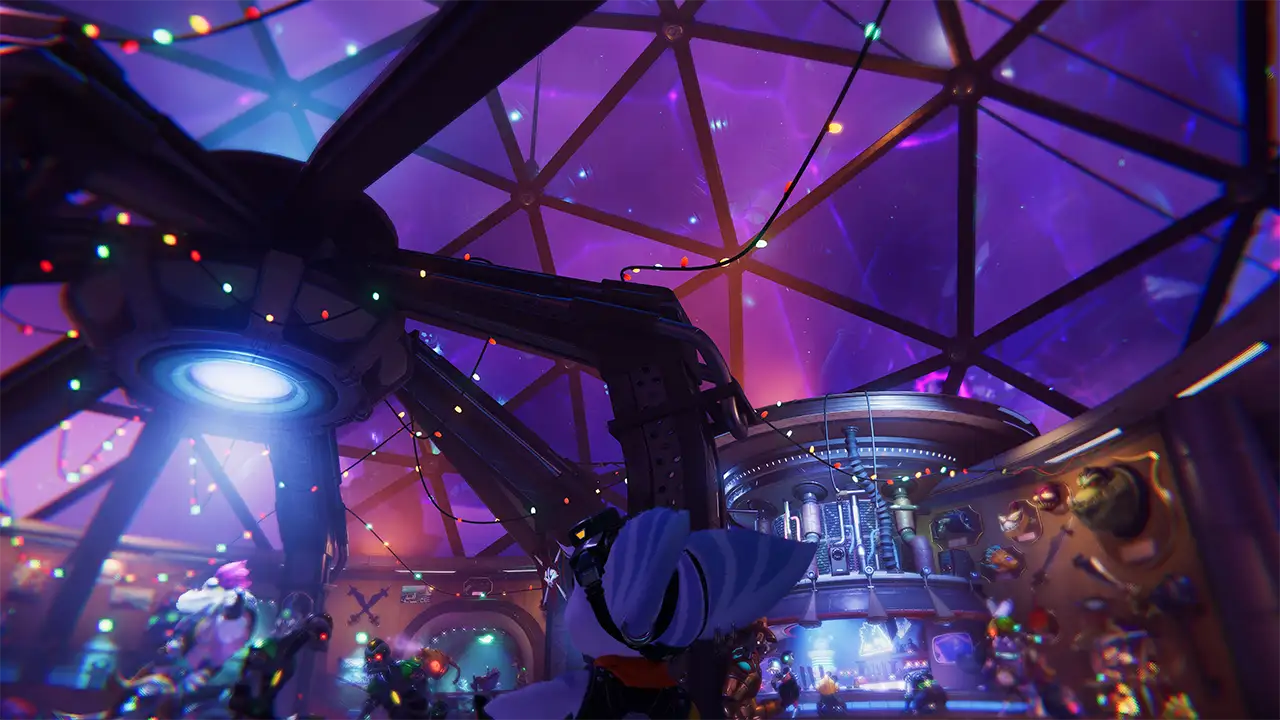


While all of the above things sound good on specs, here is what you can expect when actually gaming with it.
4080 Super Gaming Performance
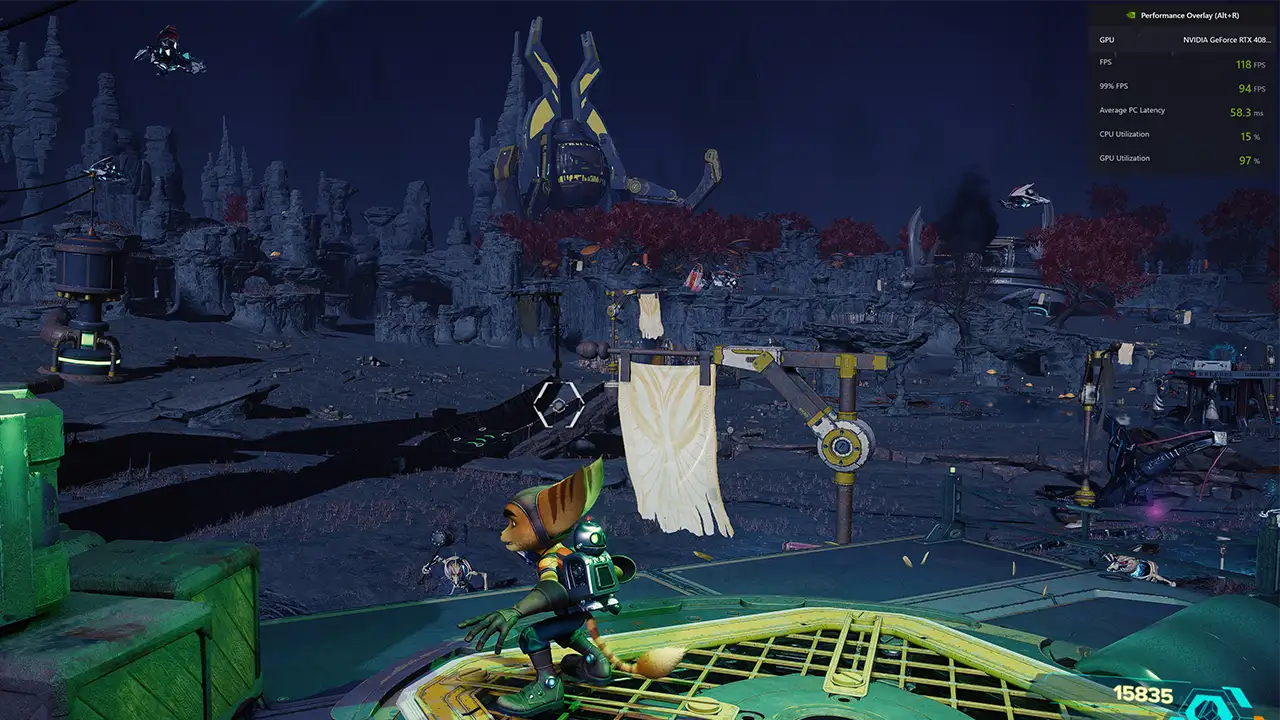
To test what all 4080 Super has to offer and its full capabilities we played several different games that demand various levels of graphical power like Tekken 8, Cyberpunk 2077, Portal and even e-sports titles Valorant, The Finals, CS2, and Overwatch 2. But for this review and a detailed comparison of FPS on multiple resolutions and using features like DLSS, Upscaling, and Ray Tracing let us take a look at how well it did in Ratchet and Clank: Rift Apart.
Before starting I haven’t tested the games at 1080p, simply because this card is well capable of handling the game at such settings. So below are the average FPS and 99% FPS in 4K and 1440p resolutions. Also the Upscaling method used here is DLSS and Upscale Quality was set to quality, performance should typically give you more FPS.
- 1440p with RTX, DLSS, and Upscaling Off:
- Average FPS: 106 FPS
- 99% FPS: 61 FPS
- 1440p with RTX, DLSS, and Upscaling On:
- Average FPS: 98 FPS
- 99% FPS: 67 FPS
- 1440p with RTX On but DLSS and Upscaling Off:
- Average FPS: 57 FPS
- 99% FPS: 39 FPS
- 1440p with RTX Off but DLSS and Upscaling On:
- Average FPS: 158 FPS
- 99% FPS: 55 FPS
- 4K with RTX, DLSS, and Upscaling Off:
- Average FPS: 62 FPS
- 99% FPS: 36 FPS
- 4K with RTX, DLSS, and Upscaling On:
- Average FPS: 35 FPS
- 99% FPS: 31 FPS
- 4K with RTX On but DLSS and Upscaling Off:
- Average FPS: 6 FPS
- 99% FPS: 3 FPS
- 4K with RTX Off but DLSS and Upscaling On:
- Average FPS: 122 FPS
- 99% FPS: 96 FPS
In case you are new to these things and aren’t sure of what 99% FPS is, it is similar to average 1% low. This basically means it is the minimum FPS that you should get. For example, if you are in an empty area of a game you will usually get a lot more frames, but when suddenly there are too many enemies or objects to render your FPS drops down. So the 99% FPS is what you should expect the game to perform regardless of the situation.
4080 Super Vs 4080 Vs 4070 Ti Super Vs 3080 Ti
Here is a quick list of specifications of the cards you might consider going for:
| GPU Specs | 4080 Super | 4080 | 4070 Ti Super | 3080 Ti |
| NVIDIA CUDA Cores | 10240 | 9728 | 8448 | 10240 |
| Boost Clock (GHz) | 2.55 | 2.51 | 2.61 | 1.67 |
| Base Clock (GHz) | 2.29 | 2.21 | 2.34 | 1.37 |
| Memory Specs: | 4080 Super | 4080 | 4070 Ti Super | 3080 Ti |
| Standard Memory Config | 16 GB GDDR6X | 16 GB GDDR6X | 16 GB GDDR6X | 12 GB GDDR6X |
| Memory Interface Width | 256-bit | 256-bit | 256-bit | 384-bit |
| Display Support: | 4080 Super | 4080 | 4070 Ti Super | 3080 Ti |
| Maximum Digital Resolution | 4K at 240Hz or 8K at 60Hz with DSC, HDR | 4K at 240Hz or 8K at 60Hz with DSC, HDR | 4K at 240Hz or 8K at 60Hz with DSC, HDR | 7680×4320 |
| Standard Display Connectors | HDMI(2), 3x DisplayPort(3) | HDMI(2), 3x DisplayPort(3) | HDMI(2), 3x DisplayPort(3) | HDMI(3), 3x DisplayPort(4) |
| Multi Monitor | up to 4(4) | up to 4(4) | up to 4(4) | 4 |
| HDCP | 2.3 | 2.3 | 2.3 | 2.3 |
| Technology Support: | 4080 Super | 4080 | 4070 Ti Super | 3080 Ti |
| Ray Tracing Cores | 3rd Generation | 3rd Generation | 3rd Generation | 2nd Generation |
| Tensor Cores | 4th Generation | 4th Generation | 4th Generation | 3rd Generation |
| NVIDIA Architecture | Ada Lovelace | Ada Lovelace | Ada Lovelace | Ampere |
| NVIDIA DLSS | DLSS 3 | DLSS 3 | DLSS 3 | Yes |
| NVIDIA Reflex | Yes | Yes | Yes | Yes |
| NVIDIA Broadcast | Yes | Yes | Yes | Yes |
| PCI Express Gen 4 | Yes | Yes | Yes | Yes |
| Resizable BAR | Yes | Yes | Yes | Yes |
| NVIDIA® GeForce Experience™ | Yes | Yes | Yes | Yes |
| NVIDIA Ansel | Yes | Yes | Yes | Yes |
| NVIDIA FreeStyle | Yes | Yes | Yes | Yes |
| NVIDIA ShadowPlay | Yes | Yes | Yes | Yes |
| NVIDIA Highlights | Yes | Yes | Yes | Yes |
| NVIDIA G-SYNC® | Yes | Yes | Yes | Yes |
| Game Ready Drivers | Yes | Yes | Yes | Yes |
| NVIDIA Studio Drivers | Yes | Yes | Yes | Yes |
| NVIDIA Omniverse | Yes | Yes | Yes | Yes |
| Microsoft DirectX® 12 Ultimate | Yes | Yes | Yes | Yes |
| NVIDIA GPU Boost™ | Yes | Yes | Yes | Yes |
| NVIDIA NVLink™ (SLI-Ready) | No | No | No | – |
| Vulkan RT API, OpenGL 4.6 | Yes | Yes | Yes | Yes |
| NVIDIA Encoder (NVENC) | 2x 8th Generation | 2x 8th Generation | 2x 8th Generation | 7th Generation |
| NVIDIA Decoder (NVDEC) | 5th Generation | 5th Generation | 5th Generation | 5th Generation |
| AV1 Encode | Yes | Yes | Yes | – |
| AV1 Decode | Yes | Yes | Yes | – |
| CUDA Capability | 8.9 | 8.9 | 8.9 | 8.6 |
| VR Ready | Yes | Yes | Yes | Yes |
| Card Dimensions: | 4080 Super | 4080 | 4070 Ti Super | 3080 Ti |
| Length | 304 mm | 304 mm | Varies by manufacturer | 12.3″ (313 mm) |
| Width | 137 mm | 137 mm | Varies by manufacturer | 5.4″ (138 mm) |
| Slot | 3-Slot | 3-Slot | Varies by manufacturer | 3-Slot |
| Thermal and Power Specs: | 4080 Super | 4080 | 4070 Ti Super | 3080 Ti |
| Maximum GPU Temperature (in C) | 90 | 90 | 90 | – |
| Idle Power (W) (5) | 15 | 13 | 12 | – |
| Video Playback Power (W) (6) | 22 | 21 | 17 | – |
| Average Gaming Power (W) (7) | 246 | 251 | 226 | 93 |
| Total Graphics Power (W) | 320 | 320 | 285 | 350 |
| Required System Power (W) (8) | 750 | 750 | 700 | 750 |
Verdict – Should You Buy the new RTX 4080 Super?
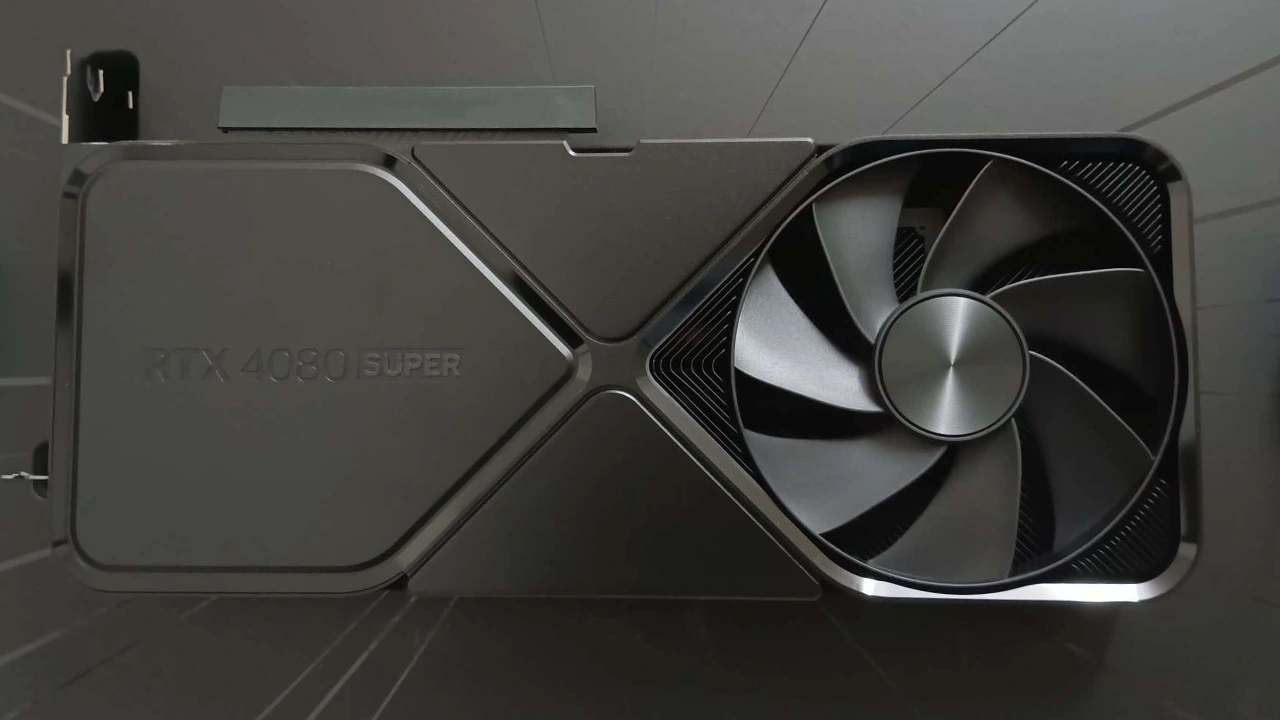
For its price of $999 USD, it is definitely worth buying the 4080 Super. But if you are still not sure then here are some other factors that you can consider, firstly the main other competition you get in this price bracket is the AMD Radeon RX 7900 XTX, and another is the original GeForce RTX 4080 which still costs $1199.
Now, if you can get the original 4080 for less than 4080 Super’s current price via some retailer or if it is second-hand but still in good condition, then you can also consider buying the original 4080. Since there isn’t that big of a performance boost, upgrading to a 4080 Super won’t be worth it if you already have the original or if you can manage to get your hands on one for a good deal.
As for comparing it with the AMD Radeon RX 7900 XTX which also comes at the same price as the 4080 Super, the 7900 XTX isn’t able to compete with the 4080 Super when it comes to its features of Ray Tracing, Upscaling, and more. However, if you aren’t too big of a fan of Ray Tracing, and if AMD decides to drop the price of 7900 XTX to maybe 849$ or 899$, then it could definitely be worth picking.
Finally, for an honorable mention, we have the 4070 Ti Super Vs the 4080 Super, and the thing you should take into account here is that the 4080 Super has 10240 CUDA Cores while the 4070 Ti Super has 8448. So even though most of the other specs might be the same, this makes a difference and in games, you can feel that as 4080 Super gives you anywhere around 14% to 20% better performance. So if you are already spending 799$ on a graphics card it might be better to push your budget a bit for the 4080 Super.
As for my thoughts and experience while gaming on the 4080 Super, the best case uses I would recommend for it would be to either play games on 4K with DLSS and Upscaling on and RTX off or bring the resolution down to 1440p and have everything set to max with RTX on. While the card can surely handle 4K and RTX the only problem is in some games it doesn’t give a constant 60 FPS which might be a bit disappointing for some players. Again this varies from game to game, but if you are looking for an overall consistent performance that doesn’t affect your play the latter settings would help.
If you are planning to play E-sports games then 4080 Super is an extremely easy pick to suggest as it provides a high frame rate even on higher resolutions. It supports 4K at 240Hz or 8K at 60Hz with DSC, HDR. Additionally, as seen above in the competition for its price this card is 2nd or the 3rd best card in the market available now depending on the game you are playing. Mainly being defeated by none other than the GeForce RTX 4090, but what you should also keep in mind is that the 4090 is a $1599 card and most manufacturers are presently selling it from $1799 to even as high as $1999, which is double the cost of the 4080 Super.
So in conclusion no matter if your gaming needs are 1440p or 4K, whether you are looking for something E-sports, casual, or even heavy gaming, the new 4080 Super is worth buying for the price!

